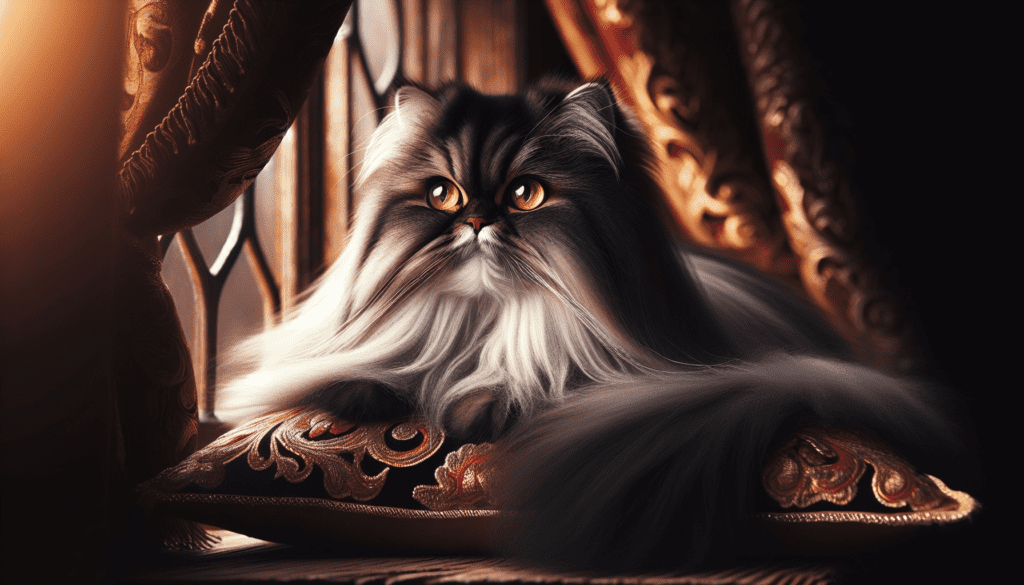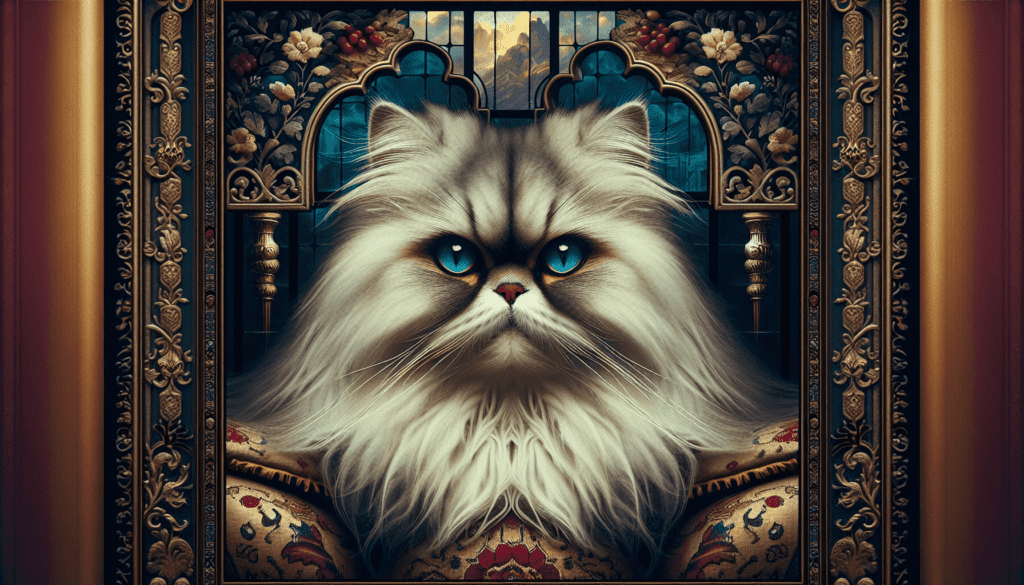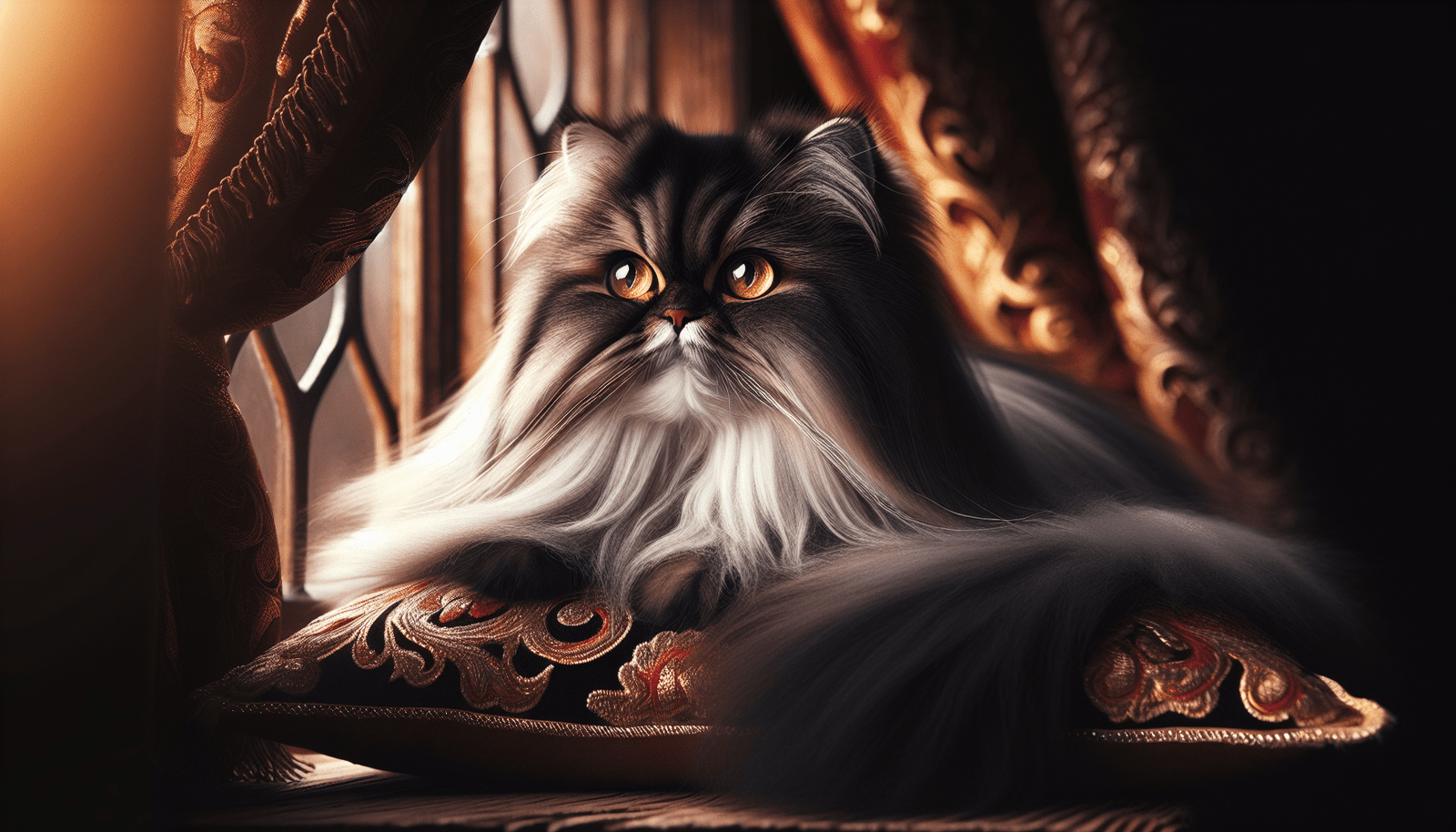Persian cats, with their luxurious coats and strikingly expressive eyes, have captivated the hearts of cat lovers around the world. But have you ever wondered about the history and origins of these regal felines? Dating back to ancient times, Persian cats were originally bred for their beauty and grace, adored by Persian nobility for centuries. In this article, we’ll take a fascinating journey through time, uncovering the ancient lineage and cultural significance of these majestic creatures. From their royal beginnings to their popularity in the modern world, prepare to be enthralled by the captivating tale of the Persian cat.

Ancient Origins
Introduction to Persian cats
Persian cats, known for their luxurious coats and regal appearance, are one of the oldest known cat breeds. These beautiful felines have captivated humans for centuries with their charm and grace. The history of Persian cats is deeply intertwined with ancient Persia, now modern-day Iran, where they were first recognized and revered.
Connection to ancient Persia
The roots of Persian cats can be traced back to ancient Persia, where they were greatly adored and cherished. These cats were considered to be sacred creatures, often kept in royal households and esteemed for their beauty and elegance. It is believed that they were brought to Europe in the 17th century by Italian traders, further establishing their presence on the global stage.
Appearance and characteristics
One of the most distinguishing features of Persian cats is their distinctive appearance. They possess a round face with large, expressive eyes that exude warmth and gentleness. Their compact bodies are adorned with a long, flowing coat that requires regular grooming to maintain its lusciousness. Persian cats are medium to large in size, with sturdy bone structure and a graceful, balanced posture. Their sweet and docile nature adds to their overall appeal, making them a popular choice among cat enthusiasts.
Persian Cats in History
Early documentation
The history of Persian cats can be documented through various ancient texts and artifacts. These references highlight the significance of Persian cats in the daily lives of ancient Persians, emphasizing their role as companions and symbols of prosperity. These cats were often depicted in intricate artwork, further showcasing their elevated status in society.
Popularity in Europe
During the 17th century, Persian cats gained popularity in Europe, particularly amongst the aristocracy. Their enchanting beauty and calm temperament made them highly sought-after pets, and their arrival marked a new era for the breed. European nobles cherished their Persian cats and treasured them as symbols of refinement and sophistication.
Introduction to the United States
In the late 19th century, Persian cats made their way to the United States. They were initially imported from Europe and quickly captured the hearts of cat lovers across the country. The breed’s popularity spread rapidly, and it wasn’t long before they were recognized and embraced by cat fanciers as a prized addition to the American cat fancy.
Breed Development
Bred for companionship
Persian cats were initially bred for their enchanting beauty and gentle disposition, making them outstanding companions. These cats were favored for their calm and placid nature, which made them well-suited for indoor living. Their loving and loyal temperament endeared them to their human counterparts, and they soon became beloved household pets.
Appeal to aristocracy
With their striking appearance and serene demeanor, Persian cats naturally appealed to the aristocracy. In Europe, these regal felines were often seen lounging in the grand salons and lavish rooms of noble households. Their presence not only added a touch of elegance, but also symbolized prestige and refined taste.
Evolution of breed standards
Over the years, breeders worked diligently to refine and enhance the characteristics of Persian cats. The development of breed standards ensured that each Persian cat possessed specific physical attributes, such as the distinctive round face, large eyes, and dense, flowing coat. These standards provided a benchmark for breeders to maintain the breed’s unique and captivating appearance.
Distinctive Features
Physical appearance
The physical appearance of Persian cats is undeniably captivating. Their round faces are adorned with a short, upturned nose and large, expressive eyes that radiate warmth and kindness. The head is set on a well-balanced body, supported by sturdy legs and a graceful, flowing tail. This harmonious combination of features contributes to the irresistible charm of Persian cats.
Coat types and colors
One of the most outstanding features of Persian cats is their luxurious coat. Persian cats have long hair that can come in a range of colors and patterns, including solid, tabby, tortoiseshell, and colorpoint. They also exhibit a variety of coat types, such as the traditional doll-face Persian with a less extreme facial structure, and the peke-face Persian with a more exaggerated flat face.
Facial characteristics
The distinctive facial characteristics of Persian cats are cherished by enthusiasts worldwide. Their broad, round faces are accentuated by large, round eyes, which can come in a variety of colors, including blue, green, and copper. Persian cats have a sweet and innocent expression that captures the hearts of all who encounter them.

Persian Cats as Show Cats
The rise of cat shows
Cat shows gained popularity in the late 19th century, providing a platform for cat enthusiasts to showcase and celebrate various breeds, including Persian cats. These events created a sense of community among cat lovers and fostered healthy competition. They played a significant role in promoting the breed’s unique qualities and establishing their presence in the world of feline excellence.
Persian cats in competitive events
Persian cats have always been a favorite in competitive cat shows due to their exquisite beauty and refined demeanor. Judges evaluate various aspects of a Persian cat’s appearance, including coat quality, body structure, and facial features. Cats that meet the strict breed standards are awarded accolades, fostering a sense of pride among breeders and owners alike.
Importance of breed standards
Breed standards play a crucial role in cat shows and the overall preservation of the Persian breed. They serve as a benchmark against which cats are evaluated, ensuring that each cat adheres to the desired physical characteristics of the breed. These standards contribute to maintaining the integrity and consistency of the Persian cat lineage, securing their prominence in the world of cat fancy.
Cultural Significance
Symbolism in Persian culture
In Persian culture, cats hold a special place of honor and reverence. Persian cats are often associated with good luck, prosperity, and protection against evil spirits. Their graceful presence and calm temperament make them highly valued, and they are regarded as cherished companions and symbols of grace and elegance.
Persian cats in art and literature
The beauty and allure of Persian cats have inspired artists and writers throughout history. They have been immortalized in paintings, sculptures, and literary works, serving as muses for artists seeking to capture their captivating essence. The image of a Persian cat lounging majestically or gazing pensively into the distance has become an iconic representation of feline charm and sophistication.
Royal associations
Persian cats have long been associated with royalty and nobility, reflecting their historical presence in the courts of ancient Persia and Europe. The regal demeanor and exquisite beauty of these felines naturally align them with concepts of grandeur and opulence. It is no wonder that they have become synonymous with elegance and dignity throughout the ages.
Challenges and Controversies
Health issues in Persian cats
While Persian cats are undeniably enchanting, they are not without their health challenges. Due to their unique facial structure and long coats, Persian cats are prone to certain health issues, including respiratory problems and eye conditions. Breeders and owners must be vigilant in maintaining their cats’ health and ensuring proper care to minimize these potential risks.
Breeding controversies
The breeding practices surrounding Persian cats have been a subject of controversy within the cat fancy community. The pursuit of extreme physical features, such as an excessively flat face, has raised concerns about the well-being and quality of life of these cats. Responsible breeding practices that prioritize health and genetic diversity are crucial to preserve the breed for future generations.
Persian cats in modern society
In modern society, Persian cats continue to captivate people with their undeniable beauty and gentle nature. Their popularity persists, and they remain a cherished choice for cat lovers seeking a calm and loving companion. However, it is essential to educate potential owners about the unique care requirements and potential health issues associated with the breed to ensure the well-being of these magnificent felines.
Popularity and Recognition
Global popularity
Persian cats have gained immense popularity worldwide and are adored by cat enthusiasts in every corner of the globe. Their unmistakable appearance and charming personality have made them beloved pets in households around the world. The timeless appeal of Persian cats transcends cultural boundaries, uniting cat lovers in their admiration for these majestic creatures.
Recognition by major cat registries
Major cat registries, such as The International Cat Association (TICA) and the Cat Fanciers’ Association (CFA), officially recognize Persian cats as a distinct breed. These prestigious organizations provide guidelines and standards to ensure the maintenance of breed integrity and promote responsible breeding practices. Such recognition further solidifies the position of Persian cats as one of the most esteemed breeds in the cat fancy world.
Role in cat fancy organizations
Persian cats play an integral role in cat fancy organizations, contributing to the diversity and richness of the feline community. They participate in exhibitions, competitions, and promotional events, captivating audiences with their undeniable charm. Their presence showcases the beauty and elegance of the Persian breed, inspiring and encouraging others to appreciate the wonders of the feline world.
Admiration and Ownership
Persian cats as pets
Persian cats are highly sought-after companions for their gentle and affectionate nature. They thrive in calm and serene households, where they can bask in the attention and love of their human companions. Their loyalty and devotion make them ideal pets for individuals seeking a tranquil and devoted animal companion.
Personality traits
Persian cats are known for their peaceful and serene disposition. They are typically laid-back and enjoy a quiet and tranquil environment. These felines have a gentle nature and tend to favor human companionship over active play. Persian cats may be wary of unfamiliar visitors, but once they establish trust, they become loving and devoted companions.
Requirements and care
Owning a Persian cat comes with specific care requirements. Their long, luxurious coats require regular grooming to prevent matting and tangles. Regular brushing, occasional bathing, and periodic visits to professional groomers are necessary to maintain their coat’s health and beauty. Additionally, due to their facial structure, special attention must be given to their eye health and respiratory comfort.
Future Outlook
Preserving the breed
Preserving the integrity and health of the Persian breed is crucial for its long-term survival. Responsible breeding practices that prioritize genetic diversity and prioritize health over extreme physical features are essential. Collaborative efforts among breeders, welfare organizations, and cat fanciers are needed to ensure a sustainable future for Persian cats.
Concerns over breeding practices
The pursuit of extreme physical features in Persian cats has raised concerns about their well-being and quality of life. The breeding community must actively address these concerns and prioritize the long-term health and welfare of the breed. By promoting responsible breeding practices, breeders can help alleviate these concerns and ensure the longevity and well-being of future generations of Persian cats.
Adaptation to changing preferences
As preferences and trends in the cat fancy world continue to evolve, it is essential for the Persian breed to adapt to these changes. Breeders must be mindful of shifting preferences and strive to produce Persian cats that meet the expectations and desires of potential owners. By embracing adaptability and evolving to meet modern demands, the Persian breed can continue to thrive and captivate cat lovers for generations to come.
In conclusion, Persian cats offer a glimpse into the rich and captivating history of the feline world. Their ancient origins, distinctive features, and cultural significance make them a breed that continues to be adored and cherished. While they face challenges and controversies, the perseverance and admiration for Persian cats ensure their enduring presence in the hearts and homes of cat enthusiasts worldwide. With responsible breeding practices and an unwavering commitment to their health and well-being, the future of Persian cats remains bright, as they continue to inspire and enchant generations to come.

